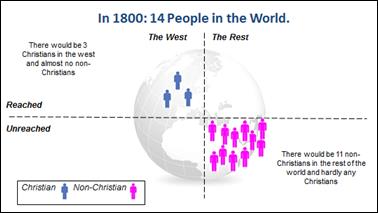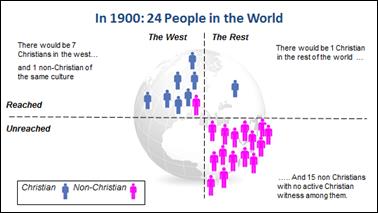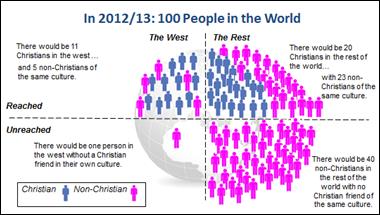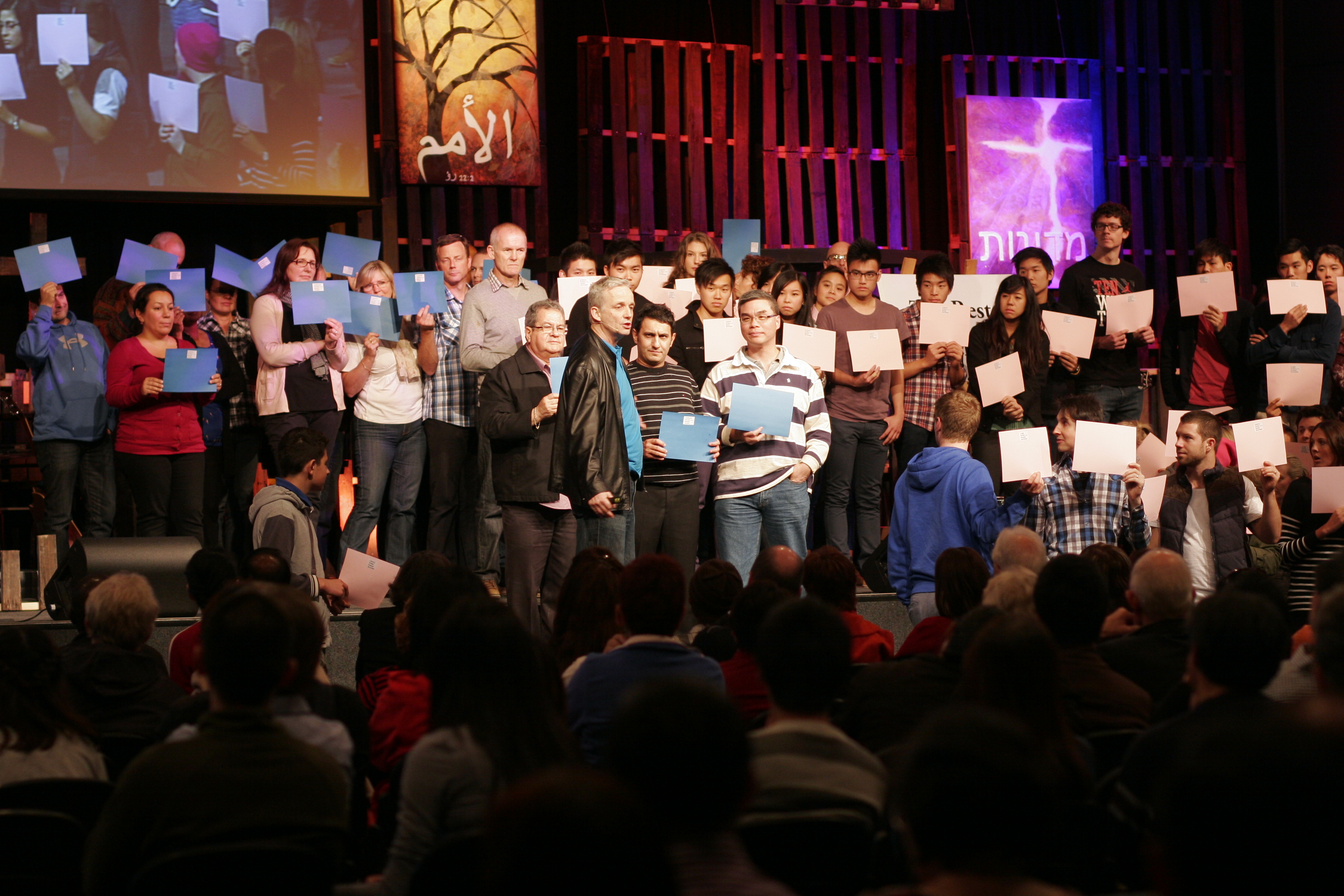Last week we looked at the story of Queen Esther and how she was called to have an impact in her time and within her place of Kingdom influence. Like Queen Esther, God has given each of us a purpose. There is a pattern to our lives which reflects not just our individual gifts and talents, but the times we live in and the circumstances of our life. Part of discovering our life pattern and purpose is discovering our gifts, but an equally important consideration is understanding the times we live in and the world in which God has placed us. When we understand the times and our place of influence we can more effectively use our gifts to have an impact for God’s Kingdom.
So what are the times we live in? Last week at our weekly celebration meetings I asked our congregation members to imagine the world today was just one hundred people. We then asked 100 volunteers from the congregation to line up near the front of the auditorium so we could create a living, breathing, tableaux showing the state of the world in 1800, 1900 and today. Some of the people were given a pink card and some a blue card. Blue was for Christians and pink for non-Christians. Each person effectively represented 70 million people.
The State of the World in 1800
 We first turned the clock back to 1800. The world population then was much smaller. There would have been 14 people then if there were 100 people now. To show the Christian status and location of these people, we asked 3 people with blue cards to stand on the platform on the left hand side as in the diagram below. They represented the western world in 1800 which was largely Christian. We then asked 11 people with pink cards to stand just below the platform on the right hand side. They represented the rest of the world who were largely non-Christian and unreached. They were unreached because there was very little active witness among them and no culturally relevant church. Yes, William Carey had been to India and there were churches in many nations outside the western world. But even by 1800, these represented a very small portion of the population in the rest of the world—not much more than “an arm or a leg”. Thus from the point of view of Christian mission, the state of the world in 1800 was relatively simple. Missions was from the Christian west to the unreached in the rest of the world.
We first turned the clock back to 1800. The world population then was much smaller. There would have been 14 people then if there were 100 people now. To show the Christian status and location of these people, we asked 3 people with blue cards to stand on the platform on the left hand side as in the diagram below. They represented the western world in 1800 which was largely Christian. We then asked 11 people with pink cards to stand just below the platform on the right hand side. They represented the rest of the world who were largely non-Christian and unreached. They were unreached because there was very little active witness among them and no culturally relevant church. Yes, William Carey had been to India and there were churches in many nations outside the western world. But even by 1800, these represented a very small portion of the population in the rest of the world—not much more than “an arm or a leg”. Thus from the point of view of Christian mission, the state of the world in 1800 was relatively simple. Missions was from the Christian west to the unreached in the rest of the world.
 We then moved forward to 1900. By 1900, there would have been 24 people in the world. As shown in the table below, there would have been seven Christians in the western world and one non-Christian. After 100 years of cross-cultural Christian mission from the west there would have been one Christian (representing 70 million people) in the non-western world. However the number of unreached non-Christians in the rest of the world without even a Christian friend or a church that communicated in their language would have grown to eleven. To represent this to our congregation, we mobilized all these people on to, or in front of, the platform and we asked them to hold up their blue and pink cards. It was clear that even in 1900, global missions was still largely all about sending missionaries from the west to the unreached in the rest of the world.
We then moved forward to 1900. By 1900, there would have been 24 people in the world. As shown in the table below, there would have been seven Christians in the western world and one non-Christian. After 100 years of cross-cultural Christian mission from the west there would have been one Christian (representing 70 million people) in the non-western world. However the number of unreached non-Christians in the rest of the world without even a Christian friend or a church that communicated in their language would have grown to eleven. To represent this to our congregation, we mobilized all these people on to, or in front of, the platform and we asked them to hold up their blue and pink cards. It was clear that even in 1900, global missions was still largely all about sending missionaries from the west to the unreached in the rest of the world.
 Between 1900 and 2012 the world radically changed. The number of people in the world grew by over 400 percent. To demonstrate these rapid changes, we mobilized another 76 people on to the platform and the front of our auditorium. The total world population in 2012 was represented by 100 people. We split these people into 17 people in the west and 83 in rest of the world. We further divided the western world into 11 Christians and six non-Christians one of whom is completely unreached. The western world has become increasingly secular. Yet most non-Christians in the west have access to the gospel in their own language, and they quite likely would have a Christian acquaintance, work colleague or friend. However, there is one unreached non-Christian in the west. That is a non-Christian living in a western country without a Christian friend or a church in their neighbourhood that speaks their language. The west has now become a cross cultural mission field in its own right.
Between 1900 and 2012 the world radically changed. The number of people in the world grew by over 400 percent. To demonstrate these rapid changes, we mobilized another 76 people on to the platform and the front of our auditorium. The total world population in 2012 was represented by 100 people. We split these people into 17 people in the west and 83 in rest of the world. We further divided the western world into 11 Christians and six non-Christians one of whom is completely unreached. The western world has become increasingly secular. Yet most non-Christians in the west have access to the gospel in their own language, and they quite likely would have a Christian acquaintance, work colleague or friend. However, there is one unreached non-Christian in the west. That is a non-Christian living in a western country without a Christian friend or a church in their neighbourhood that speaks their language. The west has now become a cross cultural mission field in its own right.
Over the same period from 1900 to 2012, the non-western part of the world has seen enormous population growth and tremendous social changes. If the world was 100 people, 83 people would now live in the rest of the world. Of these 20 would be Christians where there was only one in 1900. For the first time in world history there are now more Christians in the rest of the world than in the west. What an amazing outcome from 100 years of Christian mission. Over this period, thousands of western and non-western missionaries have given their lives in the cause of God’s mission and this has been the result. It is definitely something to praise God about!
However, there is another global pattern we need to notice. While Christianity has been growing in the non-western world so have other religions. Representing these changes, there are now 23 non-Christians in the rest of the world who have a Christian friend. They are reached but not yet Christian. But there are also now 25 more non-Christians who are completely unreached. That is 40 people in all or 40% of the global population who still have not been reached by the gospel. They may have been evangelised but not in an effective way in their own language with an active Christian community in their midst. The visual picture at the front of our auditorium was very impacting as we saw forty people crowding into whatever space was left at the bottom left hand side of our platform.
Once our living, breathing tableaux of the world today was compete, we asked our congregation to take a moment to pause and reflect on the picture in front of them. I would ask you to do the same thing. What does it show you? What implications do you think it could have for your own life and ministry? Here are some of the thoughts I have had as I considered this picture. First it is clear that, not only is the task of making disciples of all nations incomplete, it is a bigger task than ever. Second, there is some really good news. There is now a huge group of Christians in the rest of the world, many of who are actively working towards global evangelisation. Mission is no longer about only about sending missionaries from the west to the rest of the world. It is now a time of partnership, where the western church is joining with the church in the rest of the world and together we are working as one body to fulfil God mission of discipling nations. Finally, there is also now an opportunity that is almost unique in world history. We can each be a cross-cultural missionary at home. There are unreached peoples of different culture living within our neighbourhood.
More than ever, I am impacted by the thought that God is calling each of us at such of time as this to have a heart, not just for our neighbours of the same race, culture and social background, but also for the unreached of different cultures and social backgrounds. Many of these unreached people live in some of the poorest and most persecuted parts of the world. However, in partnership with the church in the rest of the world, multi-cultural western churches such as ours can have an impact in the nations, help reach the unreached, and make a difference in the lives of impoverished and oppressed communities. We are all called to God’s kingdom for such a time as this. We can all participate in God’s missions of making disciples in every people group in our generation. We can all be part of proclaiming a Kingdom message of justice, mercy and peace in the nations of the world today. The age of missions is not over and the potential for everyone to be involved is greater than ever.
– Andrew

